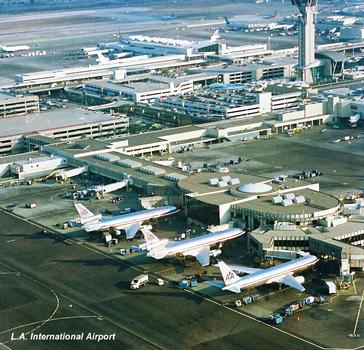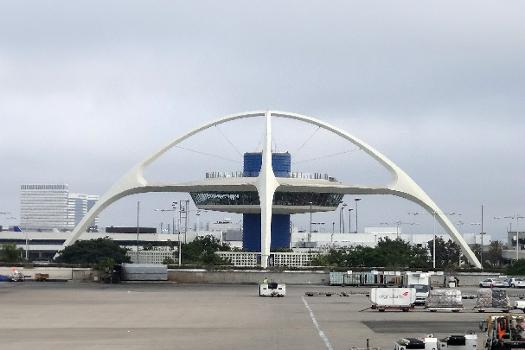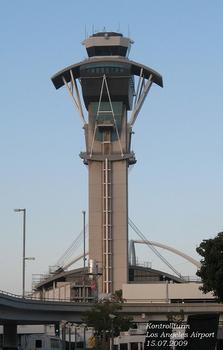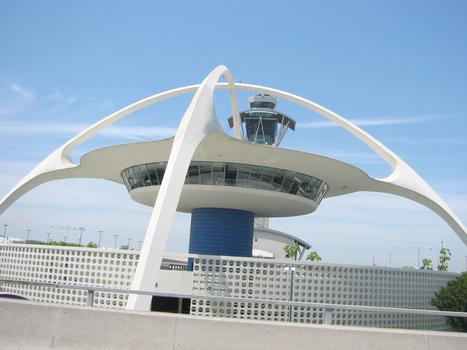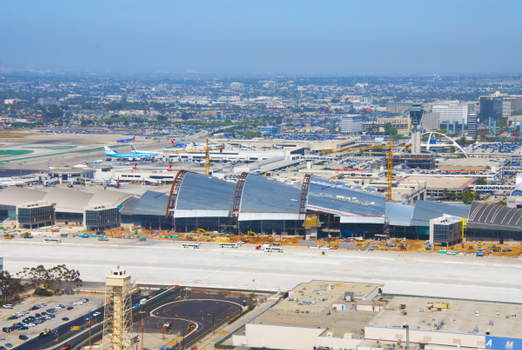General Information
| Official designation: | IATA: LAX ICAO: KLAX |
|---|---|
| Completion: | 1 October 1928 |
| Status: | in use |
Project Type
| Function / usage: |
Airport |
|---|
Location
| km | Name |
Technical Information
Dimensions
| site area | 1 416 ha | |
| runway 6L/24R | width | 46 m |
| length | 2 720 m | |
| runway 6R/24L | width | 46 m |
| length | 3 135 m | |
| runway 7L/25R | width | 61 m |
| length | 3 685 m | |
| runway 7R/25L | width | 46 m |
| length | 3 382 m |
Excerpt from Wikipedia
Los Angeles International Airport (IATA: LAX, ICAO: KLAX, FAA LID: LAX), commonly referred to as LAX (with each of its letters pronounced individually), is the primary international airport serving Los Angeles, California, United States, and its surrounding metropolitan area.
LAX is in the Westchester district of the city of Los Angeles, California, 18 miles (30 km) southwest of Downtown Los Angeles, with the commercial and residential areas of Westchester to the north, the city of El Segundo to the south and the city of Inglewood to the east. Owned and operated by Los Angeles World Airports (LAWA), an agency of the government of Los Angeles, formerly known as the Department of Airports, the airport covers 3,500 acres (1,400 ha) of land. LAX has four parallel runways.
In 2018, LAX handled 87,534,384 passengers, making it the world's fourth busiest and the United States' second busiest airport following Hartsfield-Jackson Atlanta International Airport. As the largest and busiest international airport on the U.S. West Coast, LAX is a major international gateway to the United States, and also serves a connection point for passengers traveling internationally. The airport holds the record for the world's busiest origin and destination airport, since relative to other airports, many more travelers begin or end their trips in Los Angeles than use it as a connection. It is also the only airport to rank among the top five U.S. airports for both passenger and cargo traffic.
LAX serves as a hub or focus city for more passenger airlines than any other airport in the United States. It is the only airport that four U.S. legacy carriers (Alaska, American, Delta, and United) have designated as a hub and is a focus city for Air New Zealand, Allegiant Air, Norwegian Air Shuttle, Qantas, Southwest Airlines, and Volaris. While LAX is the busiest airport in the Greater Los Angeles Area, several other airports, including Hollywood Burbank Airport, John Wayne Airport, Long Beach Airport, as well as Ontario International Airport, also serve the area.
History
In 1928, the Los Angeles City Council selected 640 acres (1.00 sq mi; 260 ha) in the southern part of Westchester for a new airport. The fields of wheat, barley and lima beans were converted into dirt landing strips without any terminal buildings. It was named Mines Field for William W. Mines, the real estate agent who arranged the deal. The first structure, Hangar No. 1, was erected in 1929 and is in the National Register of Historic Places.
Mines Field opened as the airport of Los Angeles in 1930 and the city purchased it to be a municipal airfield in 1937. The name became Los Angeles Airport in 1941 and Los Angeles International Airport in 1949. In the 1930s the main airline airports were Burbank Airport (then known as Union Air Terminal, and later Lockheed) in Burbank and the Grand Central Airport in Glendale. (In 1940 the airlines were all at Burbank except for Mexicana's three departures a week from Glendale; in late 1946 most airline flights moved to LAX, but Burbank always retained a few.)
Mines Field did not extend west of Sepulveda Boulevard; Sepulveda was rerouted circa 1950 to loop around the west ends of the extended east–west runways (now runways 25L and 25R), which by November 1950 were 6,000 feet (1,800 m) long. A tunnel was completed in 1953 allowing Sepulveda Boulevard to revert to straight and pass beneath the two runways; it was the first tunnel of its kind. For the next few years the two runways were 8,500 feet (2,600 m) long.
The "X" in LAX
Before the 1930s, existing airports used a two-letter abbreviation based on the weather stations at the airports. At that time, "LA" served as the designation for Los Angeles Airport. But with the rapid growth in the aviation industry the designations expanded to three letters c. 1947, and "LA" became "LAX." The letter "X" has no specific meaning in this identifier (just like the X in DXB - Dubai). "LAX" is also used for the Port of Los Angeles in San Pedro and by Amtrak for Union Station in downtown Los Angeles.
Theme Building
The distinctive white googie Theme Building, designed by Pereira & Luckman architect Paul Williams and constructed in 1961 by Robert E. McKee Construction Co., resembles a flying saucer that has landed on its four legs. A restaurant with a sweeping view of the airport is suspended beneath two arches that form the legs. The Los Angeles City Council designated the building a Los Angeles Historic-Cultural Monument in 1992. A $4 million renovation, with retro-futuristic interior and electric lighting designed by Walt Disney Imagineering, was completed before the Encounter Restaurant opened there in 1997 but is no longer in business. Visitors are able to take the elevator up to the Observation Deck of the "Theme Building", which closed after the September 11, 2001 attacks for security reasons and reopened to the public on weekends beginning on July 10, 2010. Although, as of April 2019, the hours of operation had not been consistent as the Observation Deck had been not been open at all during weekends [failed verification] Additionally, a memorial to the victims of the 9/11 attacks is located on the grounds, as three of the four hijacked planes were originally destined for LAX. The Bob Hope USO expanded and relocated to the first floor of the Theme Building in 2018.
Runways
Since 1972, Los Angeles World Airports has adopted the "Preferential Runway Use Policy" to minimize noise. During daylight hours (0630 to 0000), the normal air traffic pattern is the "Westerly Operations" plan, named for the prevailing west winds. Under "Westerly Operations", departing aircraft take off to the west, and arriving aircraft approach from the east. To reduce noise from arriving aircraft during night hours (0000 to 0630), the air traffic pattern becomes "Over-Ocean Operations". Under "Over-Ocean", departing aircraft continue to take off to the west, but arriving aircraft approach from the west unless otherwise required to approach from the east due to reduced visibility or easterly winds. As the name implies, "Easterly Operations" is used when prevailing winds have shifted to originate from the east, typically during inclement weather and Santa Ana conditions. Under "Easterly Operations", departing aircraft take off to the east, and arriving aircraft approach from the west.
The "inboard" runways (06R/24L and 07L/25R, closest to the central terminal area) are preferred for departures, and the "outboard" runways are preferred for arrivals. During noise-sensitive hours (2200 to 0700) and "Over-Ocean Operations", the "inboard" runways are used preferentially, with arrivals shifting primarily to 06R/24L and departures from 07L/25R. Historically, over 90% of flights have used the "inboard" departures and "outboard" arrivals scheme.
During westbound operations during the daytime, airplanes parked on the north complex tend to use Runway 6R/24L for almost all departures, and airplanes parked on the south complex use Runway 7L/25R for all departures requiring the left turn, and Runway 24L if they are making an immediate right turn. For arrivals, flights coming from the north tend to use Runway 6L/24R, and flights coming from the south tend to use Runway 7R/25L. For flights having a long final westbound, it could depend.
The South Airfield Complex tends to see more operations than the North, due to a larger number of passenger gates and air cargo operations. Runways in the North Airfield Complex are separated by 700 feet (210 m). Plans have been advanced and approved to increase the separation by 260 feet (79 m), which would allow a central taxiway between runways, despite opposition from residents living north of LAX. The separation between the two runways in the South Airfield Complex has already increased by 55 feet (17 m) to accommodate a central taxiway.
Terminals
LAX has nine passenger terminals with a total of 132 gates arranged in the shape of the letter U or a horseshoe. The terminals are served by a shuttle bus. The Tom Bradley International Terminal and Terminals 4, 5, 6, 7, and 8 are all connected airside via an overground passage between Terminal 4 and the Tom Bradley International Terminal, an underground tunnel between Terminals 4, 5, and 6 and above-ground walkways between Terminals 6, 7, and 8. Additional airside shuttle buses operate among Terminals 4, 6, and the American Eagle remote terminal, as well as between Terminals 2, 3, and the Tom Bradley International Terminal. There are no physical airside connections between any of the other terminals. In addition to these terminals, there are 2,000,000 square feet (190,000 m²) of cargo facilities at LAX, and a heliport operated by Bravo Aviation.
Ground transportation
Transportation between terminals
Shuttles operate to and from the terminals, providing frequent service for connecting passengers. However, connecting passengers who use these shuttles must leave and then later reenter security.
Airside connectors
Underground tunnels connect between terminals 4, 5, 6, 7, and 8, and an above-ground connector between TBIT and terminal 4 opened in February 2016.
One of the large LAX signs that greet visitors to Los Angeles International Airport. This sign is at the Century Boulevard entrance to the airport.
Freeways and roads
LAX's terminals are immediately west of the interchange between Century Boulevard and Sepulveda Boulevard (State Route 1). The 405 Freeway can be reached to the east via Century Boulevard, and the 105 Freeway can be reached to the south via Sepulveda Boulevard. Sepulveda Boulevard also goes right under the airport runways.
Bus
The closest bus stops to the terminals are the pair of opposites on Sepulveda Boulevard and Century Boulevard, served by Metro 117, Torrance 8, Metro 232, Commuter Express 574, Metro 102 to USC and the Metro Expo line, and Metro 40 to Los Angeles Union Station (owl service only).
In addition, out of a number of bus systems, many routes (local, rapid and express) of the LACMTA Metro 232 to Long Beach, Line 8 of Torrance Transit, Line 109 of Beach Cities Transit, the Santa Monica Big Blue Bus system's Line 3 and Rapid 3 via Lincoln Boulevard to Santa Monica and the Culver CityBus's Line 6 and Rapid 6 via Sepulveda Blvd to Culver City and UCLA, LADOT Commuter Express 438 to Downtown LA (Monday-Friday Rush hours AM), all make stops at the LAX Transit Center in Parking Lot C. on 96th St.,[145] where shuttle bus "C" offers free connections to and from every LAX terminal, and at the Green Line, where shuttle bus "G" connects to and from the terminals.
The Taiwanese airline China Airlines operates a bus service from LAX to Monterey Park and Rowland Heights. This service is only available for China Airlines customers.
FlyAway Bus
The FlyAway Bus is a nonstop motorcoach/shuttle service run by the LAWA, which provides scheduled service between LAX and Downtown Los Angeles (Union Station), the San Fernando Valley (Van Nuys), Hollywood, and Long Beach. The shuttle service stops at every LAX terminal. The service hours vary based on the line. All lines use the regional system of High Occupancy Vehicle lanes to expedite their trips. The Los Angeles Union Station service and a late-night branch of Metro Local route 40 are the only direct transit links between the airport and Downtown Los Angeles.
Discontinued routes for the FlyAway include West Los Angeles (Westwood), Santa Monica, and Irvine.
Metro Rail
Shuttle bus "G" offers a free connection to and from the Aviation/LAX station on the Los Angeles Metro Rail Green Line. The line was originally intended to be a people mover to connect directly to the airport terminals, but budgetary restraints and opposition from local taxi and parking lot owners impeded its progress and won.
LAX Train
An automated people mover (APM) system is an under construction train by LAWA. The LAX APM will have six stations and be 2.25 miles in traveling distance: three stations serving the central area, terminals 1-8 and the Tom Bradley International Terminal.
Heading east, the first station is a ground transportation parking structure called the "Intermodal Transportation Facility-West" that will serve employee parking, surrounding hotels access and long term airport parking. The next station will be a three level, above a ground infill transit transfer station on the LAX/Crenshaw Metro Line. At this station, the first (floor) level will be a second car/bus/bike transport facility called the "Intermodal Transport Facility-East" as well as LA Metro Rail's platform. The second level will be a bridge from the main hub to the light rail platform and APM platform with fare gates. The third level will be the APM. The last stop will be a rental car hub (parking structure) station called the Consolidated Rent-A-Car-Center (CONRAC). All the car rental companies and rentals will be here. The APM was designed to decrease the need for shuttle bus services and reduce traffic within the terminals World Way. The APM will have nine total trains, each operating in four car sets with capacity of containing up to 200 passengers. The APM will operate every two minutes, with a ten minute end-to-end travel time.
Los Angeles had bid for the 2024 Olympic games in 2016 and was one of two city finalists, due to decreasing demand to host the Olympics, the IOC awarded both Los Angeles and the city of Paris with Olympic games each, Los Angeles being awarded the latter, the 2028 Summer Olympics games. The project will be completed in time for the 2028 Summer Olympics in 2023 as its original projected completion date was by 2024 before the awarding. They choose to retain the original deadline. LAWA has split the project in three phases. The project has been approved and the construction and operating bidding process was commenced. Three firms submitted bids and LAWA announced scoring for the project would be based on "technical merit, visual appeal, user experience and price". LAWA proposed a public private partnership wherein a private sector partner would responsible for the construction and operation of the people mover. Los Angeles City Council gave final approval on April 11, 2018 to "LAX Integrated Express Solutions". The joint bid that included manufacturer Bombardier Transportation at 4.895 Billion over 30 years to build and operate. The three phase project is estimated to cost $5.5 billion, and have a completion date of 2023.
Construction
Phase 1
Dallas based building firm Austin Commercial was awarded a five year contract to commence construction in the first quarter of 2018 on phase one of the APM project. The project consists of bridges to connect passengers between the three proposed APM stations inside World Way and the terminals. The bridges will also house restrooms, Airport lounges offices and other spaces. The project is expected to finish by 2021, followed by phases two and three that will consist of the people mover and off site buildings. In January 2018, a consortium led by Hochtief and Bombardier Transportation was selected as the preferred developer to be awarded the $1.95 billion design/build/operate contract.
Phase 2
In 2018, 2,100 parking spaces in lot C were removed to reconfigure the area for phase two, the parking structures. Utility relocation started in the second quarter of 2018. The guideway started construction in spring 2019, It will take up to three years to complete. Groundbreaking was held in March 2019. The "Intermodal Transportation Facility - West" began construction in summer of 2019.
Coast Guard Air Station Los Angeles
The airport also functioned as a joint civil-military facility, providing a base for the United States Coast Guard and its Coast Guard Air Station Los Angeles facility, operating four HH-65 Dolphin helicopters, which covers Coast Guard operations in various Southern California locations, including Catalina Island. Missions include search and rescue (SAR), law enforcement, aids to navigation support (such as operating lighthouses) and various military operations. In addition, Coast Guard helicopters assigned to the air station deploy to Coast Guard cutters.
The air station relocated by May 18, 2016 from LAX to accommodate the planned improvements for LAX's midfield, including the Midfield Satellite Concourse North (MSC North) terminal. The air station moved to U.S. Navy's Naval Air Station Point Mugu, part of the Naval Base Ventura County (NBVC) in Point Mugu.
Flight Path Learning Center & Museum
The Flight Path Learning Center is a museum located at 6661 Imperial Highway and was formerly known as the "West Imperial Terminal". This building used to house some charter flights (e.g. Condor Airlines, Martinair Holland, World Airways) and regular scheduled flights by MGM Grand Air. It sat empty for 10 years until it was re-opened as a learning center for LAX.
The center contains information on the history of aviation, several pictures of the airport, as well as aircraft scale models, flight attendant uniforms, and general airline memorabilia such as playing cards, china, magazines, signs, even a TWA gate information sign. The museum also offers school tours and a guest speaker program.
The museum's library contains an extensive collection of rare items such as aircraft manufacturer company newsletters/magazines, technical manuals for both military and civilian aircraft, industry magazines dating back to World War II and before, historic photographs and other invaluable references on aircraft operation and manufacturing.
The museum has on display "The Spirit of Seventy-Six," which is a DC-3 (DC-3-262, Serial No. 3269). After being in commercial airline service, the plane served as a corporate aircraft for Union Oil Company for 32 years. The plane was built in the Douglas Aircraft Company plant in Santa Monica in January 1941, which was a major producer of both commercial and military aircraft.
The museum claims to be "the only aviation museum and research center situated at a major airport and the only facility with a primary emphasis on contributions of civil aviation to the history and development of Southern California". There are other museums at major airports, however, including the Udvar-Hazy Center of the National Air and Space Museum adjacent to Washington Dulles Airport, the Royal Thai Air Force Museum at Don Mueang Airport, the Suomen ilmailumuseo (Finnish Aviation Museum) at Helsinki-Vantaa Airport, the Frontiers of Flight Museum at Dallas Love Field, the Tulsa Air and Space Museum & Planetarium at Tulsa International Airport and others.
Text imported from Wikipedia article "Los Angeles International Airport" and modified on July 22, 2019 according to the CC-BY-SA 4.0 International license.
Participants
Currently there is no information available about persons or companies having participated in this project.
Relevant Web Sites
Relevant Publications
- : Architecture + Design LA. The Understanding Business Press, Berkeley (USA), pp. 16.
- About this
data sheet - Structure-ID
10000312 - Published on:
15/06/2003 - Last updated on:
08/07/2024

